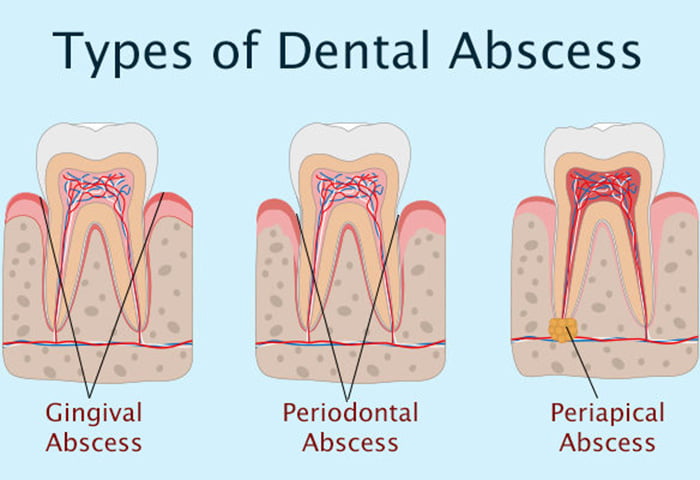The simplest description of an infection is when germs invade your body and increase their footprint quickly. Infections can come in the form of bacteria, fungi, a virus, yeast, or other microorganism, but the important thing to remember is that they can start anywhere in your body and shouldn’t be ignored.
Your mouth isn’t immune to infection, and a dental abscess is a type of oral issue that often has its origins in poor dental hygiene.

What is a dental abscess?
A dental (tooth) abscess is a pus-filled sac that forms in the teeth and gums. It is caused by a bacterial infection. An abscessed tooth is a serious dental condition that occurs when a tooth’s root becomes infected. This can happen due to a number of reasons, including cavities, gum disease, or an injury to the tooth. An abscessed tooth is extremely painful has high risk of causing serious health problems if left untreated.
The origins of dental abscesses
A dental infection that leads to an abscess can emerge on your gums, jaw, and even your face. The causes of an abscess include:
- Cavities
- Tooth infections
- Gum infections
The broad types of abscesses are divided into three groups: gingival, periodontal, and periapical.
Gingival infections typically start because something gets stuck in your gum, such as food or part of a broken tooth that may get lodged in it if you’ve had an accident. Periodontal abscesses are the results of a bacterial infection in your gums, while periapical abscesses happen when the pulp inside a tooth becomes infected. Periapical abscesses are the most frequently diagnosed type of abscess.
In addition to slacking on good dental hygiene, alcohol consumption, smoking, and nutritional deficits contribute to the development of abscesses. Further, certain medications and medical conditions can make your teeth more susceptible to cavities, which sets you up for an abscess.
Different types of dental abscess
Based on its origin, there are three types of dental abscesses: gingival, periodontal, and periapical. Gingival abscesses are rare and occur on the gum around the tooth. Periodontal abscesses occur in the gums and are less common than periapical abscesses. Periapical abscesses occur at the root of the tooth and are the most common type of abscess.

Dental abscesses are treated with antibiotics and, in some cases, surgery. If you think you may have an abscessed tooth, it’s important to see a dentist as soon as possible.
What are the symptoms of a dental abscess?
The signs of a dental abscess aren’t pretty. Pus accumulates at your infection site. The pain increases until the abscess either ruptures by itself or we drain it surgically. If an abscess isn’t treated, symptoms can become quite serious. A patient with an abscess may experience swelling that can block the airway, which impedes breathing, and even sepsis, a life-threatening condition in which the infection spreads throughout your system and your body’s immune system no longer protects, but rather harms you.

The infection can also progress to the point where you experience other severe symptoms, like chills, vomiting, and fever. These symptoms alone are daunting and reason enough to take a dental abscess seriously.
Over-the-counter pain medications can relieve abscess pain, and if your abscess pops and drains on its own, simply rinse your mouth with warm water. However, if this doesn’t happen, it’s important to seek treatment from a dental professional.
The dentist can also rupture the abscess to make it drain, and some patients get their abscess drained through the tooth prior to a root canal procedure. He may also prescribe pain relievers and antibiotics if needed and the abscess is traced to a bacterial infection.
Very serious abscesses can affect the floor of your mouth or your neck, and these need to be addressed surgically.
How are dental abscesses treated?
There are different ways to treat a dental abscess. Treatment for a dental abscess involves draining the pus and cleaning the area. Your dentist will determine the best treatment based on your age, overall health, medical history, and other factors. The most common treatment include draining the abscess. To drain the abscess, your dentist will make a small incision into the abscess, which drains the pus. This process can be uncomfortable, but it is usually well-tolerated. Antibiotics may be needed to aid clearing the infection. You should feel the immediate relief effect the next day. Later, a root canal, filling and crown are normally indicated. Your dentist can also remove the source of the pain by pulling out a decaying or damaged tooth, which is the last option. Pain relievers can help manage the pain and reduce the discomfort.
You should be able to return to school or work within a few days after the procedure(s).

The value of emergency dentistry services
Dental abscesses are a prime example of a condition that can balloon in seriousness until you realize you need immediate care from your dentist. We often think of getting a tooth knocked out after an accident or experiencing pain that’s hard to tolerate as being true dental emergencies, but an abscess certainly belongs in this category as well.
The severity of an abscess generally defines whether it requires treatment by a professional. As we noted before, the abscess may take care of itself, but if it doesn’t, seek treatment from us to get your abscess properly and safely drained. Then you can get on the road to healing.
See Dentist For Life
Looking for an experienced and trusted dentist in Marysville, Ohio? Look no further than Dentist For Life! We provide comprehensive dental care for patients of all ages. We take a wide variety of insurance plans and are currently accepting new patients. You can reach us at (937) 707-1111 or schedule your appointment online here.


